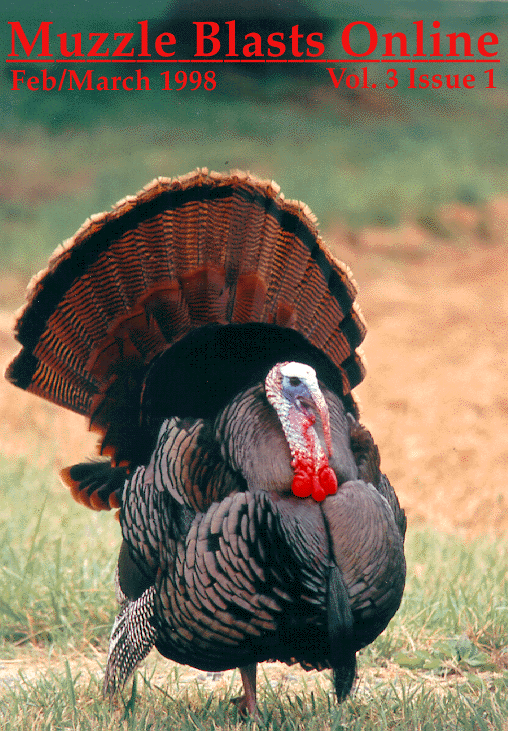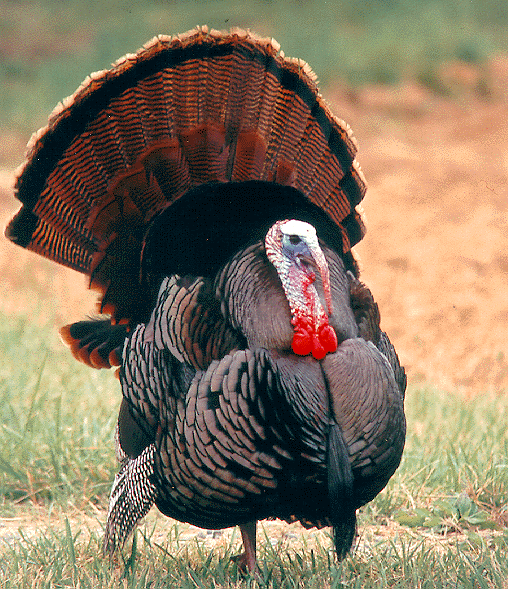|
Muzzle Blasts Online |
|
...for the muzzleloading enthusiast |
|
The muzzleblasts.com domain, subdomains, content, etc., are neither affiliated with the NMLRA nor its paper magazine Muzzle Blasts |
|
Muzzle Blasts Online |

|
|
|
|
|
|
Spring Turkey with a Muzzle Loading Shotgun
Occasionally those of us who take to the fields and streams have a perfect day. Whether we are bass fishing or hunting deer or hogs, there are times when everything seems to go perfectly, and achieving our goal of harvesting a big buck or catching a limit of fish seems almost too easy. I guess these perfect outings make up for the times when our rewards are simply being there in the great outdoors, rather than bringing home the bacon! This past spring, my friend Mark Balette from East Texas and I experienced the spring turkey hunt of a lifetime. We chose to collect our birds the old-fashioned way, with a muzzle loading shotgun. That really made the outing special.

|
|
Tom Turkey
|
Well before this spring hunt, I knew the Joy Ranch was a turkey hunting haven, a spot where we could enjoy a couple days of spring muzzle loader hunting and call up a gobbler or two within range of our 12 gauge T/C New Englander shotguns. We found lush vegetation in Schleicher county--a welcome sight from the drab brown and grays of late winter. Recent rains had created ideal nesting conditions on the ranch, and the day before our hunt the area had been pounded with a series of thunderstorms which dumped a couple extra inches of rain on an already soaked landscape. The morning of our hunt broke clear and cool. I felt the birds would be actively involved in their spring ritual of mating; I was sure they were in the thick cedars trying to escape the violent weather the day before. With the clear, cool morning, the gobblers would be out looking for a little early morning female companionship as soon as they flew off their roosts. Little did I know that my friend and I had chanced to scheduled our hunt at the peak of the breeding season when gobblers were aggressively seeking receptive hens.
The area we chose to hunt was about a two-mile drive from our camp. We eased the GMC Suburban through the gate leading into what has been aptly named "The Turkey Pasture." It's actually not a pasture at all but a creek bottom laced with oaks, cedars, and mesquite trees, and bounded on one side by a mini "mountain" that rises a hundred feet above the bottoms. On the other side there is a big flat covered with a thick growth of cedars, mesquite, and live oaks. There are plenty of roosting sites along the creek, dense cover, and feed; what more could a turkey ask from its home range? A couple calls on the ol' barred owl hooter brought instant responses from several gobblers roosting in the live oaks along the creek. It was difficult to tell just how many gobblers answered our owl call because they began sounding off before I could finish the "who cooks for you, who cooks for you all" sequence on the call. The predawn woods reverberated with the bass gobbling of five to ten different gobblers. We were, as they say, in the eye of the hurricane! Rather than risk spooking the birds, Balette and I decided to get back into the brush, on the edge of a little clearing about a hundred yards from the roosting birds, and begin our calling at first light. We placed our three Feather Flex turkey decoys in the clearing, carefully measured 110 grains of Pyrodex and poured it down the barrel of our New Englanders. Next we placed a felt wad over our powder charge and poured 1½ ounces of #4 shot down the bore, followed by another wad. Our turkey load, made on the spot, was as effective as anything that comes ready-rolled, and we were both confident that the loads had the punch to harvest cleanly the largest of gobblers. In previous tests with the T/C New Englander, I had used the same load to shoot though a five gallon bucket at thirty yards.
We used our hunting knives to remove a few cedar limbs to use as camo in a makeshift blind. Once in position, we capped our shotguns and I began working the box call. This was Balette's first spring turkey hunt, and I wanted him to harvest a big gobbler with a muzzle loader; besides, I love to call! With the first hen yelps, the woods again resounded with gobbling. This time it sounded like two or three birds were answering, and all three responses seemed to be coming from the same direction. It appeared that gobblers were still in bachelor groups, which meant they would be aggressively seeking hens. A gobbler that has already selected a mate is next to impossible to coax away even with the best calling.
I could hear the birds getting closer and closer to our position after each sequence of hen yelps. They were not the least bit shy: their response to the call was immediate and loud. It was obvious the birds were intent on finding a love sick hen somewhere in the brush. The color of a strutting Rio Grande gobbler with the early morning sunshine lighting up his iridescent plumage is magnificent, and Balette and I both were spellbound when three gobblers strutted into view. Brilliant shades of blue, green and red stood out in bold contrast against the early spring woods. The birds made a beeline for the hen decoys, circled them a couple times, occasionally brushing against and pecking their would-be friends. I am sure the larger gobbler sporting the nine-inch beard never had time to realize these pieces of painted foam weren't the real thing.
Balette centered the bead of his shotgun on the tom's head and squeezed the trigger. The New Englander belched out a column of white smoke, and when it cleared, there was a twenty-two-pound gobbler on the ground about thirty yards from our stand. The two smaller jakes high-tailed it out of sight post haste. Balette's first spring gobbler was on the ground within thirty minutes of the beginning of our hunt. We still had the remainder of the day and another full day to enjoy the thrill of calling these supercharged birds within muzzle loader range.
In retrospect, I believe we could have stayed put in our blind and continued to call turkeys within shooting range, but we decided to move. We eased a couple hundred yards down the flat and set up and called again. The response was the same as at our blind: we heard a couple of distant gobblers sound off. As before, they answered every time they heard the call.
When hunting spring turkeys, one learns to expect the unexpected. A jake came strutting into view around a cedar bush no more than twenty yards away. He made no sounds; he just appeared. We could still hear the two other gobblers closing the distance; they sounded at least a hundred yards out. I am definitely not a "trophy" turkey hunter. I love eating fresh turkey, and to me, a young, tender jake tastes as good on the smoker or grill as prime rib. The shot was close and the New Englander once again did an excellent job of anchoring a gobbler in his tracks.
After a couple hours in the turkey woods, we had two birds on the ground! Balette was beginning to wonder if turkey hunting is always this easy. I assured him it is not. On previous hunts, I have worked hard locating gobblers on roosts, gotten into the woods well before sunup, and still failed to coax a single bird within shooting range. When mother nature sets the stage for a perfect hunt, you simply relax and let it happen. This is exactly what Balette and I did on this hunt.
We headed back to camp, cleaned the birds, and prepared some breast meat for the evening meal. I had been bragging to my buddy about just how good fresh turkey breast is, and he was anxious to give it a try. We filleted one of the breasts, placed the fillets in a zip lock freezer bag, and seasoned the meat with Cajun seasoning and hot sauce. With the makings of our evening meal on ice in the cooler, we relaxed around camp a couple hours and ate a lunch comprised of homemade smoked venison sausage and wild hog taken with our muzzle loaders the previous winter.
We spent the remainder of the afternoon looking the ranch over. Just before sundown, we decided to roost a few more birds for the next morning's hunt. We returned to another section of the "Turkey Pasture", and just as the sun dipped over the top of the live oaks, I again used the barred owl hooter. Again, I was treated to an instant response from several gobblers along the creek. The next morning's hunt was an exact replica of the previous day. We had another gobbler on the ground by 8:30, and as fishermen might say, we left them biting! We had a long drive ahead of us and quite a bit of work breaking camp. Muzzle loading shotguns are ideal for turkey hunting. A quality modern Muzzle loading shotgun can be safely loaded to equal the "magnum" loads of conventional shotguns, and, as our hunt proved, they are capable of anchoring the biggest of gobblers. We found the single-shot New Englanders to preform well, but for the turkey hunter wishing for a bit more fire power, there is always the option of using a double barrel.
I know you are interested in how those turkey fillets turned out. For the evening meal, we fired up the campfire, dusted the well-seasoned fillets with flour, and dropped them into a cast iron skillet with hot oil. A pot of rice was cooking on the other burner. When the fillets were done to a turn, we made a skillet of cream gravy. The evening meal put the finishing touches on what was a "perfect" spring turkey hunt.